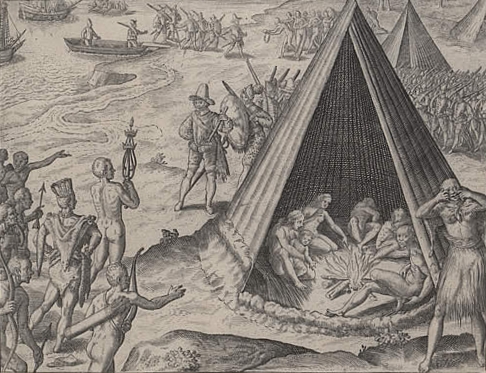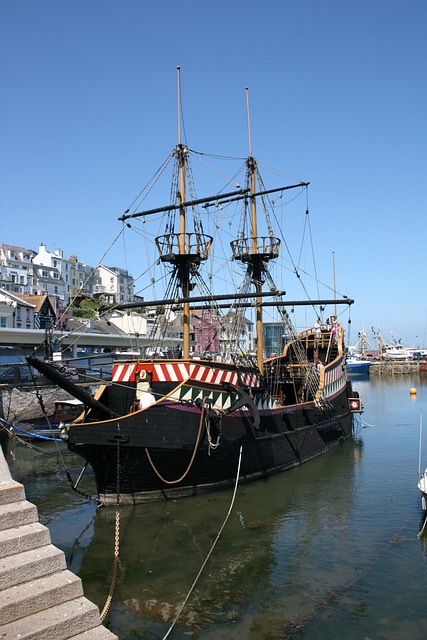Five centuries ago, Sir Francis Drake had a hero’s return from the first English circumnavigation of the globe, bringing home treasure to a delighted Queen Elizabeth. But how much of a hero was Drake in reality? Fresh from his appearance on Channel 5’s ‘Great British Ships‘, Reading historian Dr Richard Blakemore explores some lesser known truths about this momentous voyage.

On 26 September 1580 a ship sailed into Plymouth harbour. The men aboard must have been jubilant: when they set sail aboard the Pelican three years before, they had thought they were making a relatively short trip to Alexandria. This small ship had instead completed a three-year circumnavigation of the world, the first by any English vessel. It was most likely the longest voyage any of these men had undertaken, and while they were at sea their ship was rechristened with the name by which it is now much more famous: the Golden Hinde.
An uncertain return
On reaching the English coast Francis Drake, the captain, anxiously asked the fishing boats who came to meet them an urgent question: was the queen alive? The purpose of his voyage had been to attack Spanish shipping in the Pacific Ocean, but he had kept his destination secret, even from his own crew, because England and Spain were not officially at war. Drake had the queen’s support, but if she had died while he was away, his position would be very dangerous indeed.
Drake was fortunate. Queen Elizabeth was not only alive, she was delighted by the treasure he had brought home, plundered from Spanish galleons. Half of those riches made their way into the royal treasury, a sum greater than the crown’s ordinary annual income. Elizabeth also allowed Drake to keep a substantial amount for himself and his men: we cannot be certain how much each sailor received, but it was probably more than they could have earned in several years. The Golden Hinde itself was moored at Deptford, to publicly display and celebrate Drake’s achievement.
American adventures
In navigational terms, as well as financial, the voyage certainly was an achievement. Drake set sail with four ships, but only the Pelican went further than the Atlantic Ocean. He made his way through the dangerous Magellan Straits and, after rampaging along the Pacific coast of South America, and pausing briefly in what is now California, Drake launched out into the Pacific. After reaching Indonesia, the now-renamed Golden Hinde crossed the Indian Ocean, rounded Africa, and sailed the length of the Atlantic Ocean for a second time.
At times, the ship spent months together at sea, far longer than was usual at that time. A crew of around eighty men lived in cramped, and often cold and wet, quarters on the ship, and faced all the considerable perils of the sea as well as battle. Even so, Drake was also attentive to his men’s welfare, and took care to provide fresh provisions whenever possible. Despite the length of the voyage, fewer men were lost to disease than in many later transoceanic voyages.

Drake’s darker side
Yet there was a ruthless side to Drake as well. The first leg of the voyage was disrupted by conflict between Drake and Thomas Doughty, a friend of Drake’s and an experienced soldier, who seemed to think they should share command. On the coast of South America, Drake tried and executed Doughty for mutiny, an action for which Drake almost certainly had no legal authority. Doughty’s relatives sought to prosecute Drake when he returned to England, but it was impossible to touch the queen’s favourite.
There was a similarly dubious legality about Drake’s private war with the Spanish empire. He claimed that the Spanish crown had done him personal wrong, and that he was entitled to make ‘reprisal’ against them by raiding their empire. The Spanish authorities certainly saw things differently, considering Drake to be a corsario luterano, a heretic and a pirate.
Whatever the legal situation, Drake’s conduct was pitiless, and partially inspired by religious fanaticism. He and his men burned churches, threatened priests, and reportedly tortured their captives to make them reveal their hidden treasure. While Drake liberated some African slaves in Spanish America, with a few joining his crew, he also abandoned three such slaves – one of them pregnant – on an island in the Banggai Archipelago in Indonesia. He may have done this to protect his reputation and avoid allegations when he returned to England.
Drake and his men overcame remarkable challenges in the course of their three-year journey, and they came back rich; but they left many victims behind in their wake. This voyage therefore reflects the harshness of early modern seafaring, and both Drake’s successful navigation and haul of plunder, and the brutal means by which he achieved them, foreshadow the maritime empire Britain would later build.
Dr Richard Blakemore appeared in ‘Great British Ships: The Golden Hinde’ on Saturday 19 January 2019. The episode is available on the Channel 5 website. Learn more about Dr Blakemore’s research and teaching, including his module on piracy in the period 1550-1750.
